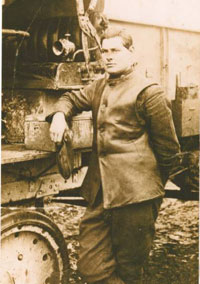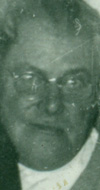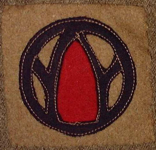
 Walter No-T Price, Draftee
Walter No-T Price, Draftee
Sometimes it takes years for a couple of ideas to drift together. I have an high school girl's understanding of World War I. It was horrible. Trench warfare. Too many young men died and the "war to end all wars" only paved the way for Hitler and World War II. And I think I saw all the movie versions of "All's Quiet on the Western Front." But it's still an abstraction.
I have also always known than my grandfather was in World War I and that (unlike my father's war) he was in real battles. A family history that my father compiled listed his division and regiment, that he was an engineer, and that he was involved in Argonne and St. Mihiel.
My dad also told me that Armistice Day (now Veteran's Day), on Nov 11, was a solemn drinking occasion for his dad and uncles Frank and Tab.
Now that I am sorting through Jim's stacks of WWI materials, suddenly I'm curious.
On the "bottomless shelf" there is a comprehensive book of American Armies and Battlefields in Europe during the Great War. It was a thrilling moment to find his Division listed and to verify his Regiment of Engineers. And then to see the movement of his Division plotted on giant fold-out maps. I was touching the past, touching my grandfather's experience. The girly woman with only a post-Vietnam sense of how wars are fought was suddenly pulled into the trenches.
 My
grandfather lives for me only as a kindly and arthritic old man. Being a
carpenter with all kinds of can-do knowledge that his white collar
children had not bothered to learn, he made the rounds to our houses to
coach on fix-it projects that he was too crippled to do himself. He
believed in a job well-done. He had a silent laugh, tears appearing in
his eyes when something was really funny. He liked his beer -- a glass
of beer with Tabasco sauce was a Sunday brunch treat. He loved his
grandchildren. He was 70 when he died in 1963 -- my first loss of
someone I adored.
My
grandfather lives for me only as a kindly and arthritic old man. Being a
carpenter with all kinds of can-do knowledge that his white collar
children had not bothered to learn, he made the rounds to our houses to
coach on fix-it projects that he was too crippled to do himself. He
believed in a job well-done. He had a silent laugh, tears appearing in
his eyes when something was really funny. He liked his beer -- a glass
of beer with Tabasco sauce was a Sunday brunch treat. He loved his
grandchildren. He was 70 when he died in 1963 -- my first loss of
someone I adored.
The Great War was a bloody ordeal. My grandpa was there. Suddenly, it is less of an abstraction. I'm connected to it. I can see the trenches and the scorched landscape through his eyes. Where was he? What did he do?
Some basics:
 Walter
Price was drafted into the 314th Engineers, 89th Division, nicknamed the
"Middle West" or the "Rolling W." He was 25, already
working in the family carpentry business -- not your average
18-year-old cannon fodder. His experience got him assigned to the
engineering regiment.
Walter
Price was drafted into the 314th Engineers, 89th Division, nicknamed the
"Middle West" or the "Rolling W." He was 25, already
working in the family carpentry business -- not your average
18-year-old cannon fodder. His experience got him assigned to the
engineering regiment.
Men assigned to the 89th Division of the National Army started being drafted in August 1917 as part of the massive military build-up to go help the weary French and English beat back the Germans. The 27,000 men and 1000 officers trained at Camp Funston in Fort Riley, Kansas, and landed in France on June 21, 1918. It took them till early August to reach the front. They were a combat division now. The carpenter who liked his work squared off and leveled was officially in hell.
No hell would be complete without the statisticians. The 89th Division spent 82 days at the front: Training - 0 days; In Sector - 54 days; In Battle - 28 days. Between the operations at St. Mihiel and Argonne, they clawed their way forward a whopping 30 miles. That's about a mile a day -- think about it. And they were among the fast ones.
They were the 5th most efficient division in the American Army: of all the ground gained, they took over 6% of it. They also excelled (3rd place) at capturing German prisoners -- 5061 of them. The cost: 1496 died in battle or from their wounds and 5625 were wounded. About 7600 replacements were sent in over the course of their stay.
Sunday, 2.20.05 (rev. 12.18.06)
NOTES
American Armies and Battlefields in Europe: History, Guide, and Reference Book. Prepared by the American Battle Monuments Commission. 1938.
The Official Record of the United States' Part in the Great War prepared by the Secretary of War (no date).
What does the Engineers Regiment do? This is what I can glean:
Role of combat engineers is mobility and counter-mobility. In the heat of battle, the capacity to deliver firepower, troops and supplies to any part of the battlefield is crucial to success. Combat Engineers use their skills to overcome all physical obstacles natural and man-made, ensuring that the troops can reach their targets and fight effectively. They employ a wide variety of equipment to help troops cross physical barriers.
Counter-mobility is the term used to describe efforts to hinder the
enemy's movement. Engineers are trained to use explosive charges to
create obstacles, crater roads and destroy bridges.
Walter's Army Card can be seen in the Missouri Archives Soldiers Database (war of 1812 - World War I).
